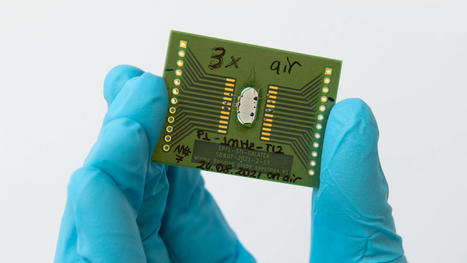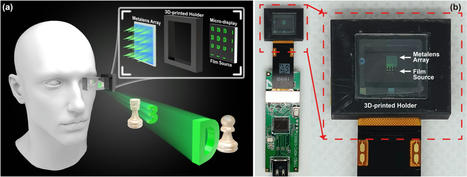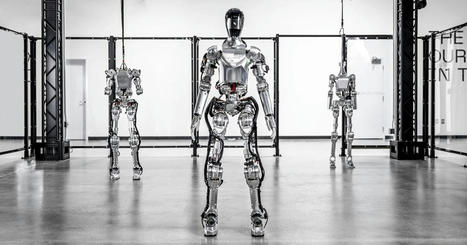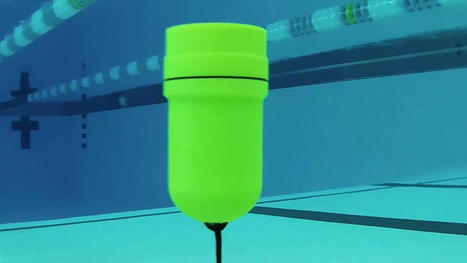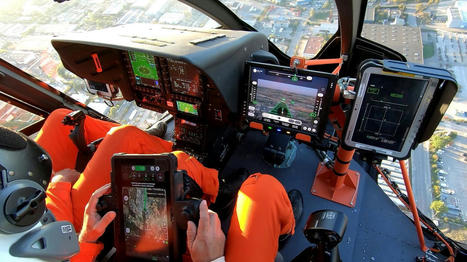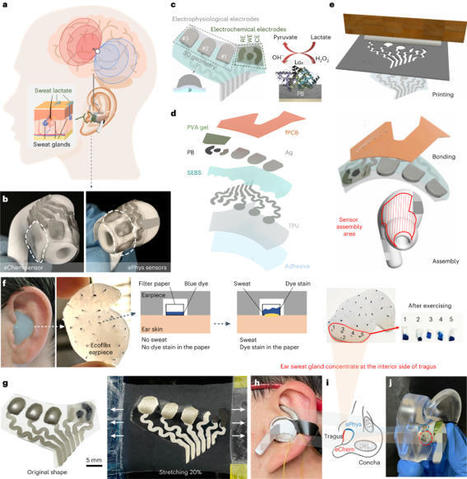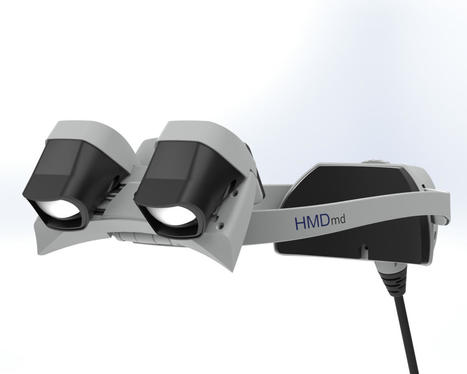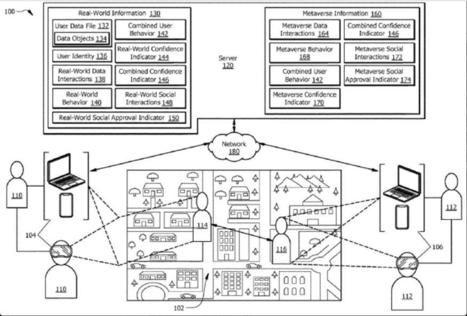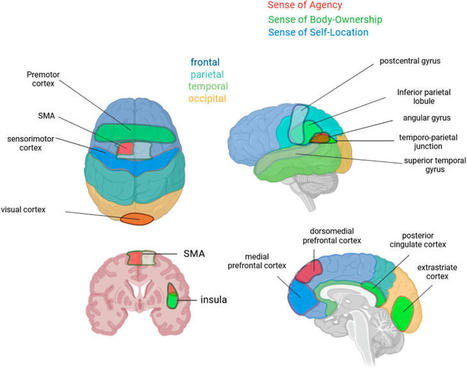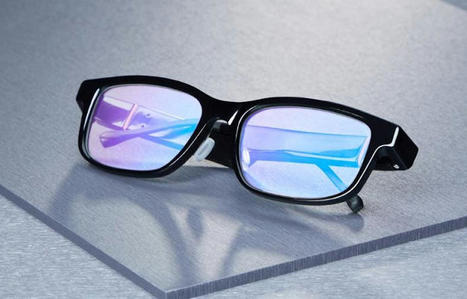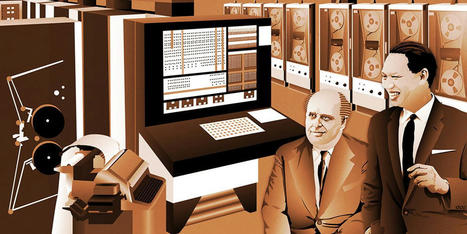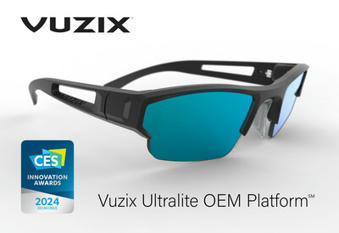 Your new post is loading...
 Your new post is loading...

|
Scooped by
Sara Mautino
January 27, 2024 3:02 PM
|
- Phys. Rev. Applied 21, 014008
"This work illustrates a pathway for locally turning a tellurite glass into a functional photoconductor of arbitrary shape, without adding materials and using a single laser process step."
"The research saw the potential for creating durable patterns on the glass surface that could produce electricity when illuminated."

|
Scooped by
Sara Mautino
January 24, 2024 4:33 PM
|
Us Pat Grant number 11556912
Methods for smartglasses-to-smartglasses payment systems is provided. Methods include receiving a transfer of funds initiation at a first smartglasses. The transfer of funds initiation may include an identifier, an amount and a personal identification number (“PIN”). Methods include transmitting the transfer of funds initiation from the first smartglasses to a second smartglasses. Methods may include receiving a notification on the second smartglasses. The notification may include a first smartglasses telephone number and the transfer of funds initiation. Methods may include transmitting a transfer of funds request from the second smartglasses to an entity. The transfer of funds request may include the first smartglasses telephone number, the transfer of funds initiation and the second smartglasses telephone number. Methods may include retrieving a first account and a second account from the entity. Methods may include transferring funds from the first account to the second account.

|
Scooped by
Sara Mautino
January 23, 2024 3:16 PM
|
Integral imaging (II) display, one of the most critical true-3D display technologies, has received increasing research recently. Significantly, an achromatic metalens array has realized a broadband metalens-array-based II (meta-II). However, the past micro-scale metalens arrays were incompatible with commercial micro-displays; furthermore, the elemental image array (EIA) rendering is always slow. The two hinders in device and algorithm prevent meta-II from being used for practical video-rate near-eye displays (NEDs). This research demonstrates a meta-II NED combining a commercial micro-display and a metalens array. The large-area nanoimprint technology fabricates the metalens array, and a novel real-time rendering algorithm is proposed to generate the EIA. The hardware and software efforts solve the bottlenecks of video-rate meta-II displays. We also build a see-through prototype based on our meta-II NED, demonstrating the feasibility of augmented reality. Our work explores the potential of video-rate meta-II displays, which we expect can be valuable for future virtual and augmented reality.

|
Scooped by
Sara Mautino
January 23, 2024 1:40 PM
|
BMW has entered a partnership with robotics startup Figure to bring autonomous robots to its manufacturing facility in Spartanburg, South Carolina.

|
Scooped by
Sara Mautino
January 22, 2024 8:58 AM
|
China's Ministry of Industry and Information Technology (MIIT) recently took a significant step to support the development of the metaverse by forming a standard-setting working group, which consists of industry giants such as Huawei, Tencent, Ant Group and Baidu, as well as leading universities and institutions. The 60-person working group will be responsible for creating and revising industry standards for the metaverse, including research on application standards for manufacturing, communications and digital humans. The group will also focus on talent training and participate in the creation of international standards for the metaverse.

|
Scooped by
Sara Mautino
January 19, 2024 3:57 PM
|
Near-eye displays are fundamental technology in the next generation computing platforms for augmented reality and virtual reality. However, there are remaining challenges to deliver immersive and comfortable visual experiences to users, such as compact form factor, solving vergence-accommodation conflict, and achieving a high resolution with a large eyebox. Here we show a compact holographic near-eye display concept that combines the advantages of waveguide displays and holographic displays to overcome the challenges towards true 3D holographic augmented reality glasses. By modeling the coherent light interactions and propagation via the waveguide combiner, we demonstrate controlling the output wavefront using a spatial light modulator located at the input coupler side. "
" In this work, we propose a display architecture that combines the advantages of both waveguide displays and holographic displays, enabling the path towards true 3D holographic AR glasses."

|
Scooped by
Sara Mautino
January 11, 2024 3:43 PM
|

|
Scooped by
Sara Mautino
January 9, 2024 2:26 PM
|
Early metaverse pioneers discuss lessons learned on a free 3D virtual platform.

|
Scooped by
Sara Mautino
December 1, 2023 2:39 PM
|
Hackster.io user Bob Hammell created these sound beacons based on conversations with “individuals who experience visual impairment firsthand, to help identify the unique needs of swimmers wit…

|
Scooped by
Sara Mautino
November 29, 2023 3:45 PM
|
The test flight under project Vertex, took flight fully automated for one hour and was controlled through a touchscreen tablet.

|
Scooped by
Sara Mautino
November 24, 2023 3:30 PM
|
Novel wearable captures body sounds for vital health monitoring Researchers from Northwestern University have developed new wearable devices that offers continuous monitoring of vital bodily sounds.

|
Scooped by
Sara Mautino
November 18, 2023 1:34 PM
|
Owing to the proximity of the ear canal to the central nervous system, in-ear electrophysiological systems can be used to unobtrusively monitor brain states. Here, by taking advantage of the ear’s exocrine sweat glands, we describe an in-ear integrated array of electrochemical and electrophysiological sensors placed on a flexible substrate surrounding a user-generic earphone for the simultaneous monitoring of lactate concentration and brain states via electroencephalography, electrooculography and electrodermal activity. In volunteers performing an acute bout of exercise, the device detected elevated lactate levels in sweat concurrently with the modulation of brain activity across all electroencephalography frequency bands. Simultaneous and continuous unobtrusive in-ear monitoring of metabolic biomarkers and brain electrophysiology may allow for the discovery of dynamic and synergetic interactions between brain and body biomarkers in real-world settings for long-term health monitoring or for the detection or monitoring of neurodegenerative diseases. An in-ear integrated array of sensors for electroencephalography, electrooculography and electrodermal activity and for lactate can be used to concurrently monitor brain states and lactate levels in sweat.

|
Scooped by
Sara Mautino
November 15, 2023 5:41 AM
|
For the first time, scientists have demonstrated that the brain’s electrical activity can be decoded and used to reconstruct music.
Artificial intelligence has turned the brain’s electrical signals into somewhat garbled classic rock"
"Neuroscientists have reconstructed recognizable audio of a 1979 Pink Floyd song by using machine learning to decode electrical activity in the brains of listeners. As study participants undergoing surgery listened to “Another Brick in the Wall (Part 1),” electrodes placed on the surface of the brain captured the activity of regions attuned to the song’s acoustic profile. "
|

|
Scooped by
Sara Mautino
January 25, 2024 5:00 PM
|
Reflections on a six-month fast from social media. I wanted to share the questions I'm asking myself after taking time away from addictive apps and algorithms.

|
Scooped by
Sara Mautino
January 23, 2024 3:35 PM
|
Kopin Corporation (NASDAQ: KOPN), a leading provider of application-specific optical solutions and high performance micro-displays for defense, enterprise, consumer and medical products, today announced it has received an initial production order for the CR3 wearable surgical monitor from HMDmd Inc (HMDmd). The CR3 is a head-mounted display (“HMD”) system that is the culmination of a multi-year development program by Kopin and HMDmd to produce a medical-grade wearable monitor that meets the exacting needs of surgeons and supporting clinical personnel. The CR3 provides full-HD resolution 3-D imagery in a lightweight, ergonomic package and is 4K video compatible. The CR3 is configured for use with 2-D and 3-D endoscopes and operating microscopes/exoscopes and is plug-in compatible with products produced by major surgical systems companies.

|
Scooped by
Sara Mautino
January 23, 2024 3:13 PM
|
Integral imaging (II) display is one of the most promising near-eye displays (NEDs) due to its compact volume, full parallax, convenient full-color display, and, more importantly, true-3D and more realistic depth perception from eliminating the vergence-accommodation conflict (VAC). However, II displays based on the conventional optical architecture, such as microlens arrays, are limited in resolution, field of view, depth of field, etc.

|
Scooped by
Sara Mautino
January 23, 2024 12:08 PM
|

|
Scooped by
Sara Mautino
January 21, 2024 1:32 PM
|

|
Scooped by
Sara Mautino
January 18, 2024 1:49 PM
|
US20240004975 "The system and methods implemented by the system as disclosed in the present disclosure provide technical solutions to the technical problems discussed above by intelligently verifying data interactions performed in a virtual environment. The disclosed system and methods provide several practical applications and technical advantages. "

|
Scooped by
Sara Mautino
January 10, 2024 12:36 PM
|
Example 1: A display system comprising: a head-mountable display configured to project light to a viewer to display image information on one or more depth planes, the display comprising: a light-emitting panel configured to produce the light, wherein the light-emitting panel is further configured to allow light from objects in a surrounding environment to pass therethrough to the viewer; a first variable focus lens assembly between the light-emitting panel and a first eye of the viewer; a second variable focus lens assembly between the light-emitting panel and the surrounding environment; and at least one sensor configured to monitor one or more characteristics of the viewer; at least one processor communicatively coupled to the light-emitting panel and the at least one sensor, wherein the at least one processor is configured to: receive output data from the at least one sensor indicating one or more characteristics of the viewer; and adjust an optical power of the first and second variable focus lens assemblies based on the output data received from the at least one sensor. Example 2: The display system of Example 1, wherein the at least one processor is configured to adjust the optical power of the first and second variable focus lens assemblies depending on a depth plane for displaying the image information. Example 3: The display system of Example 1 wherein the at least one processor is configured to adjust an optical power of the second variable focus lens assembly in response to an optical power of the first variable focus lens assembly. Example 4: The display system of Example 1, wherein one or more emitters in the light-emitting panel are configured to project divergent light to the viewer to display the image information. Example 5: The display system of Example 1, wherein the at least one sensor comprises at least one camera configured to monitor a positioning of the first eye of the viewer. Example 6: The display system of Example 1, wherein an optical power of the first and/or second variable focus lens assembly is adjusted in accordance with a prescription for correcting the viewer's vision at two or more distances. Example 7: The display system of Example 1, wherein the first and/or second variable focus lens assemblies comprises a layer of liquid crystal sandwiched between two substrates. Example 8: The display system of Example 7, wherein the first and/or second variable focus lens assemblies comprise electrodes for altering a refractive index of the liquid crystal layer upon application of a voltage. Example 9: The display system of Example 7, wherein the substrates comprise glass. Example 10: The display system of Example 1, wherein the at least one processor is further configured to vary the refractive index of the first and/or second variable focus lens assembly by application of an electrical current or voltage. Example 11: The display system of Example 1, wherein the light-emitting panel comprises an organic light-emitting diode (OLED) film. Example 12: The display system of Example 11, wherein the display further comprises an array of lenses optically coupled to the OLED film. Example 13: The display system of Example 12, wherein the lens array is positioned between the OLED film and the first variable focus lens assembly. Example 14: The display system of Example 13, wherein the lens array comprises an array of microlenses. Example 15: The display system of Example 13, wherein the lens array comprises an array of waveplate lenses. Example 16: The display system of Example 13, wherein the lens array comprises an array of wavelength-selective lenses. Example 17: The display system of Example 13, wherein the display further comprises another array of lenses positioned between the OLED film and the second variable focus lens assembly, wherein the two lens arrays have optical powers with opposite signs. Example 18: The display system of Example 12, wherein the lens array is positioned between the OLED film and the second variable focus lens assembly. Example 19: The display system of Example 13, wherein the lens array comprises an array of cholesteric liquid crystal reflective waveplate lenses. Example 20: The display system of Example 13, wherein the display further comprises a quarter waveplate positioned between the OLED film and the array of cholesteric liquid crystal reflective waveplate lenses. Example 21: The display system of Example 12, wherein each lens in the lens array is optically coupled to a respective set of pixels of the OLED film. Example 22: The display system of Example 21, wherein the at least one processor is configured to control two or more sets of pixels of the OLED film optically coupled to two or more respective lenses in the lens array according to a same illumination pattern. Example 23: The display system of Example 21, wherein each set of pixels of the OLED film is configured to display image information from a different perspective. Example 24: The display system of Example 1, wherein the display further comprises one or more layers of liquid crystal positioned between the light-emitting panel and the first variable focus lens assembly, wherein the at least one processor is configured to apply an electrical current or voltage to pixels of the one or more layers of liquid crystal to selectively occlude portions of incident light. Example 25: The display system of Example 24, wherein the at least one processor is configured to apply pulses of electrical current or voltage to pixels of the one or more layers of liquid crystal at a particular modulation frequency. Example 26: The display system of Example 25, wherein the particular modulation frequency is at least 60 Hz. Example 27: The display system of Example 1, wherein the first and second variable focus lens assemblies comprise: one or more waveplate lenses configured to provide a first optical power for light having a first polarization, and to provide a second optical power for light having a second polarization; and one or more switchable waveplates in an optical path, wherein each of the one or more switchable waveplates is configured to selectively alter a polarization state of light passing therethrough, and wherein the first and second variable focus lens assemblies are configured to provide a respective optical power that is adjustable upon application of a respective electrical signal. Example 28: The display system of Example 27, wherein the at least one processor is configured to cause the first and second variable focus lens assemblies to synchronously switch between different states in a manner such that the first and second variable focus lens assemblies impart a substantially constant net optical power to ambient light from the surrounding environment passing therethrough.

|
Scooped by
Sara Mautino
December 5, 2023 3:30 PM
|
The sense of embodiment refers to the sensations of being inside, having, and controlling a body. In virtual reality, it is possible to substitute a person’s body with a virtual body, referred to as an avatar. Modulations of the sense of embodiment through modifications of this avatar have perceptual and behavioural consequences on users that can influence the way users interact with the virtual environment. Therefore, it is essential to define metrics that enable a reliable assessment of the sense of embodiment in virtual reality to better understand its dimensions, the way they interact, and their influence on the quality of interaction in the virtual environment. In this review, we first introduce the current knowledge on the sense of embodiment, its dimensions (senses of agency, body ownership, and self-location), and how they relate the ones with the others. Then, we dive into the different methods currently used to assess the sense of embodiment, ranging from questionnaires to neurophysiological measures. We provide a critical analysis of the existing metrics, discussing their advantages and drawbacks in the context of virtual reality. Notably, we argue that real-time measures of embodiment, which are also specific and do not require double tasking, are the most relevant in the context of virtual reality. Electroencephalography seems a good candidate for the future if its drawbacks (such as its sensitivity to movement and practicality) are improved. While th

|
Scooped by
Sara Mautino
December 1, 2023 2:18 PM
|
Smartglasses just got a lot smarter.".With no display, not sure if we can define "Solos AirGo3" as "smartglasses".
For sure we expect them to be "smart".

|
Scooped by
Sara Mautino
November 25, 2023 6:23 PM
|
In 1959, Olivetti introduced one of the first transistorized mainframes and started its own transistor company

|
Scooped by
Sara Mautino
November 22, 2023 5:43 AM
|
il primo francobollo digitale della "Olivetti Collection"

|
Scooped by
Sara Mautino
November 16, 2023 6:11 PM
|
- Vuzix Ultralite S smart glasses win two CES 2024 Innovation Awards
- Sleek design represents an ideal form factor for the sport
|



 Your new post is loading...
Your new post is loading...

